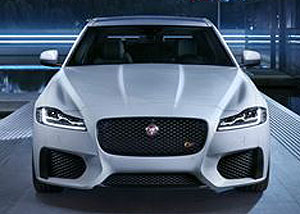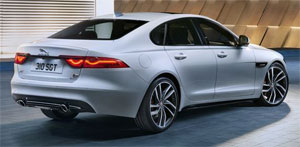2016 Jaguar XF
Jaguar has been on a roll lately, whether you’re talking about setting the pace in the F Pace or building our type of thrill ride with the F Type. Now they turn their efforts towards the more traditional XF midsize sedan. So, let’s see if they can continue to set their type of pace.
While the Jaguar F-type and F-Pace have certainly drawn lots of attention to the brand, its cars like this 2016 Jaguar XF that will truly have much more of an impact on the brand’s long term success.
Like most recent Jags and the trend of cars in general, this 2nd generation XF has dropped some pounds, riding on a new aluminum structure.
But it’s the powertrain options that are the biggest talking points about this new XF. That being the F-type’s supercharged 3.0-liter V6 available in two levels; base 340-horsepower and in upgraded S version with 380.
Both variations get an 8-speed automatic transmission with available all-wheel-drive. A diesel option will follow shortly.
 Our early drive time in Arizona was mostly spent in the more powerful XF S; and we found plenty of get up and go, no matter where we got up and went. Still, that muscle is delivered in a more civilized fashion than with brute force.
Our early drive time in Arizona was mostly spent in the more powerful XF S; and we found plenty of get up and go, no matter where we got up and went. Still, that muscle is delivered in a more civilized fashion than with brute force.
Like most vehicles, the XF has made the switch to electric power-assisted steering; and here we loved it. There’s plenty of feedback, along with a nice and direct feel. BMW take note!
We expected to see some improvement in handling, but we got even more than we anticipated. That lighter and stiffer chassis, along with the F-type inspired double-wishbone front and integral link rear suspension, provides a very agile feel, and should be just what was needed to make the XF much more competitive with its German rivals.
Ride quality equally falls on the firm side of things; not harsh, but surely stiffer than the typical American buyer will anticipate.
The ZF 8-speed is still good as it gets, delivering smooth and fast shifts no matter your driving style. Jag puts 0-60 right at 5.0-seconds. JaguarDrive Control offers a typical range of driving modes.
And, during our drive we did not find an extreme level of isolation, or disconnect. Still it was very quiet inside. The throttle is very aggressive, especially in sport mode. But unlike the boisterous F-Type, a fairly tame exhaust note reveals the XF’s clearly luxury character.
 That theme is really played out inside where the cabin is top drawer in both look and feel. Material quality has climbed exponentially; and there is plenty of space and comfort to be found at all seating positions.
That theme is really played out inside where the cabin is top drawer in both look and feel. Material quality has climbed exponentially; and there is plenty of space and comfort to be found at all seating positions.
Base gauges have a familiar look to them, but a configurable 12-inch TFT virtual gauge panel is also available. A new InControl Touch Pro system takes over the duties for infotainment, and worked well enough in our limited exposure.
The trunk area is well-finished, and holds a very generous 19.1 cubic-ft. of goods.
There are certainly more F-type notions to the updated exterior, but clearly the XF is its own cat.
The front end does wear a more aggressive look, with larger intakes and a more vertical grille, but in profile the same basic coupe-inspired shape of the previous car remains.
From the rear, things have been tidied up with cleaner lines and sharper fit to all of the pieces; which include LED taillights that are the most overt homage to the F-Type. Standard wheels are 18s, with the S rolling on 20s.
All of the expected safety systems including Autonomous Emergency Braking are available.
 So while this new XF has improved across the board and perhaps gotten a little more accessible, we think it’ll still appeal most to the buyer who’s looking for something other than a ubiquitous German sport sedan.
So while this new XF has improved across the board and perhaps gotten a little more accessible, we think it’ll still appeal most to the buyer who’s looking for something other than a ubiquitous German sport sedan.
The lighter weight and more efficient powertrain has improved the XF’s Government Fuel Economy Ratings to 20-City, 30-Highway, and 24-Combined. For an average Energy Impact Score of 13.7-barrels of oil consumed and 6.2- tons of CO2 emitted yearly.
Pricing starts at $52,895 for a 35t Premium, with the XF S beginning at $63,695.
The 2016 Jaguar XF was certainly due for an update, as the previous gen had been around since 2009. But, this thorough redesign does much more than just carry on business as usual in the midsize luxury sport sedan segment. With huge gains in both posh and performance, much like the F-type, it’s primed to have a major impact on its segment. This cat is on the prowl.
Specifications
- Engine: 3.0 liter V6
- Horsepower: 340 / 380
- Torque: 332 lb-ft.
- 0-60 mph: 5.0 seconds
- EPA: 20 mpg city/ 30 mpg highway
- Energy Impact: 13.7 barrels of oil/yr
- CO2 Emissions: 6.2 tons/yr
2025 Volkswagen ID. Buzz
Volkswagen Brings Beetlemania Level Of Excitement To Minivan Segment
The duty of upholding Volkswagen’s heritage has most recently been delegated to small legacy car names like Golf and Jetta. But hold on! A much larger, totally modern take on VW’s classic microbus has just buzzed over the horizon— the all-electric ID. Buzz. It’s been at the top of our minds since we first saw the concept back in 2017. Well, it’s finally here, so let’s get our groove into drive!
This 2025 Volkswagen ID. Buzz has indeed created the most buzz around Volkswagen since the Beetle’s return to the U.S. in the late 1990s. We couldn’t drive it anywhere without drawing a crowd. No wonder, just about everyone has a VW Microbus story to tell, and seeing this reimagined version rolling down the street brings back all those memories.
VW really pulled it off as far as we’re concerned, as it looks great without appearing over the top. All the cues are here: Big VW logo front and center, lots of greenhouse including A-pillar windows and mini sliders for the second-row passengers, D-pillar air vents, and two-tone wheels. And while its appearance may be pure retro, its drivetrain is far from it, as the ID. Buzz is all-electric, and unlike the new Beetle, the Buzz does retain the original Microbus’ rear-drive architecture.
Powering those rear wheels is a 210-kW motor drawing juice from a 91-kWh battery for a range of 234 miles; 200-kW max charging will get you to 80% in about 26 minutes. Buyers can add another small 80-kW motor up front for 4motion all-wheel-drive and an increase of total output from 282 to 335 horsepower with a combined 512 lb-ft of torque. It uses the same battery, but range estimates drop just slightly to 231 miles. But while those numbers are modest, we also found them to be quite conservative, as we observed as many as 287 miles available in our all-wheel-drive tester’s gauge display and were on pace for 273 miles in our driving loop.
One throwback theme that may be a turnoff to some is that it’s quite a step up into the Buzz’s front seats, but there’s certainly a commanding view of the road once you climb in. Second row seating can be either a three-place bench or a pair of captain’s chairs, so there’s generous room for seven or six passengers. The captain’s chairs in our Pro S Plus offer good support and very easy access to the third row.
Lots of flexibility too with the option to simply fold the seats or remove them altogether.
With the sliding side doors and a wide opening rear hatch, there’s plenty of access for loading big sport utility amounts of cargo. Lots of flexibility too with the option to simply fold the seats or remove them altogether, and the ability to create a full-length flat floor with a rear cargo shelf that covers some handy removable storage bins. There’s 18.6 cubic-feet of space behind the third row, 75.5 behind the second, and a max of 145.5. That’s more than a Chevrolet Tahoe. For smaller items, there are lots of cubbies throughout the cabin, along with a standard Buzz Box that can be moved to multiple locations.
With a design that prioritizes retro form and modern function over aero efficiency, the 4motion equipped ID. Buzz earns a Fair efficiency rating, using 42-kWh of electricity per 100 miles, and we weren’t sure what to expect at our Mason Dixon test track.
What we found was great torque off the line and drama free launches to 60 in just 5.3 seconds. It was very stable at speed and power delivery stayed steady most of the way down the track until we reached about 90 mph, when it began to taper off just before we finished the quarter-mile in 14.0 seconds flat at 97 mph.
With 1,200-lbs. of battery weight nestled in its 127.5-inch wheelbase, the Buzz felt planted to the pavement through our handling course. There was quite a bit of body roll to deal with, but surprisingly little understeer. In panic braking runs, pedal response was inconsistent, feeling soft at times, pushing back hard at others; but through it all, results were quite good, stopping from 60 in an average of just 108 feet.
Three interior themes are available, this Dune is the brightest, featuring coastal inspired wood optic dash décor, “gray and clay” leatherette surfaces, and a high-mounted central 12.9-inch touchscreen. Pricing starts with a rear-wheel-drive Pro S at $61,545; this Pro S Plus begins at $65,045, add another $4,500 for 4motion, which brings a few extra features along with all-wheel drive.
Retro design with old-school VW charm, modern EV drivetrain, big SUV capacity merged with minivan flexibility; it all comes together in this 2025 Volkswagen ID. Buzz. It’s easily one of the coolest rides of the year and one that will likely keep Volkswagen dealers buzzing for years to come, and that’s something no other people and things mover can say.
Specifications
As Tested
- Motor Setup: Dual-Motor AWD
- Battery Size: 91-kWh
- Horsepower: 335
- Torque: 512 lb-ft
- EPA Range: 231 miles
- 0-60 mph: 5.3 seconds
- 1/4 Mile: 14.0 seconds at 97 mph
- Braking, 60-0: 108 feet
- MW Test Loop: ~ 273 miles













































